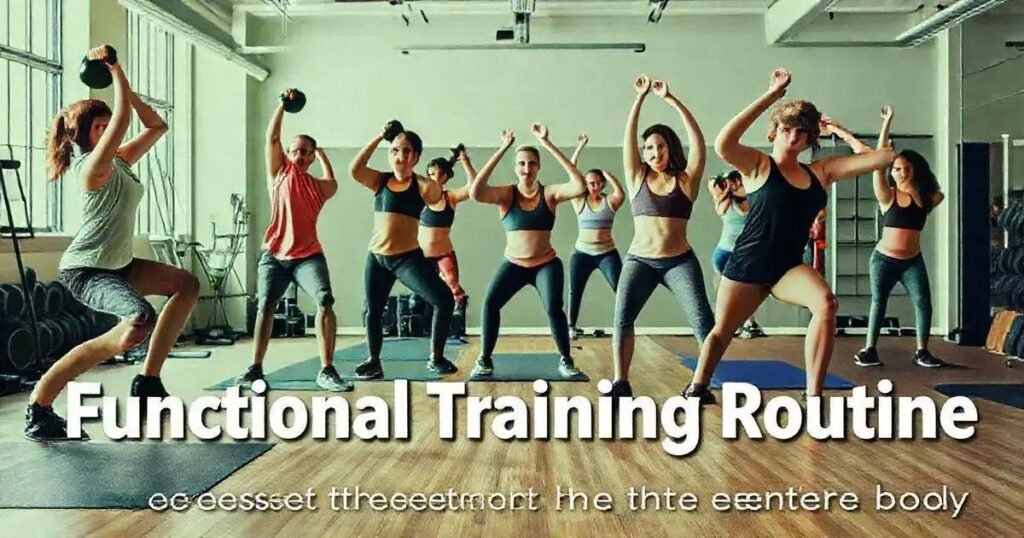Are you tired of hitting the gym and not seeing the results you want? Perhaps you’re stuck in a rut, doing the same exercises day in and day out, without much progress.
It’s time to shake things up with functional training! This innovative approach to fitness focuses on building strength, improving coordination, and enhancing overall athleticism – all while keeping you engaged and challenged.
By incorporating functional training into your routine, you’ll not only get fit, but also improve your daily functioning and overall well-being.
Table of Contents
Understanding the Concept of Functional Training
Functional training is a type of exercise that focuses on improving coordination, balance, and overall athleticism. It involves performing exercises that mimic real-life movements and scenarios, such as squatting to pick up a child or jumping over obstacles. This approach to fitness is designed to improve functional strength, which is the ability to use your muscles to perform daily activities and movements. Unlike traditional weightlifting, which focuses on isolated muscle groups, functional training combines multiple muscle groups to create a more comprehensive workout.
The benefits of functional training for fitness are numerous. For one, it improves overall athleticism, making it easier to perform daily activities and movements. Additionally, functional training can help improve coordination and balance, reducing the risk of injury. It also improves core strength, which is essential for stability and posture. Furthermore, functional training can help improve flexibility and range of motion, making it easier to move and perform daily activities. Best of all, functional training can be adapted to any fitness level, making it accessible to everyone.
Designing a functional training workout involves identifying your goals and creating a routine that targets specific muscle groups. Start by selecting a few exercises that mimic real-life movements, such as squats, lunges, and deadlifts. Then, create a circuit or routine that combines these exercises with other movements, such as jumping, hopping, and crawling. Consider incorporating resistance bands or kettlebells to add resistance and challenge. Finally, incorporate exercises that target your core and flexibility, such as planks and leg swings.
Some key exercises for functional training include squats, lunges, and deadlifts. These exercises mimic real-life movements, such as picking up a child or carrying groceries. Other exercises, such as burpees, jump squats, and box jumps, are designed to improve coordination and balance. Additionally, exercises like planks, side plank, and leg raises target the core and improve flexibility. Remember to start slow and gradually increase the intensity and difficulty of the exercises as you progress.
Incorporating functional training into your routine can be challenging, but there are a few tips to help you get started. First, start slow and gradually increase the intensity and difficulty of the exercises. Second, focus on proper form and technique to avoid injury. Third, incorporate exercises that target your core and flexibility, such as planks and leg swings. Finally, consider working with a personal trainer or fitness coach to create a customized functional training routine that meets your specific needs and goals.
Benefits of Functional Training for Fitness
The benefits of functional training for fitness are numerous. It improves overall athleticism, making it easier to perform daily activities and movements. Additionally, functional training can help improve coordination and balance, reducing the risk of injury. It also improves core strength, which is essential for stability and posture. Furthermore, functional training can help improve flexibility and range of motion, making it easier to move and perform daily activities. Best of all, functional training can be adapted to any fitness level, making it accessible to everyone.
Designing a functional training workout involves identifying your goals and creating a routine that targets specific muscle groups. Start by selecting a few exercises that mimic real-life movements, such as squats, lunges, and deadlifts. Then, create a circuit or routine that combines these exercises with other movements, such as jumping, hopping, and crawling. Consider incorporating resistance bands or kettlebells to add resistance and challenge. Finally, incorporate exercises that target your core and flexibility, such as planks and leg swings.
Key exercises for functional training include squats, lunges, and deadlifts. These exercises mimic real-life movements, such as picking up a child or carrying groceries. Other exercises, such as burpees, jump squats, and box jumps, are designed to improve coordination and balance. Additionally, exercises like planks, side plank, and leg raises target the core and improve flexibility. Remember to start slow and gradually increase the intensity and difficulty of the exercises as you progress.
Incorporating functional training into your routine can be challenging, but there are a few tips to help you get started. First, start slow and gradually increase the intensity and difficulty of the exercises. Second, focus on proper form and technique to avoid injury. Third, incorporate exercises that target your core and flexibility, such as planks and leg swings. Finally, consider working with a personal trainer or fitness coach to create a customized functional training routine that meets your specific needs and goals.
Designing a Functional Training Workout
When designing a functional training workout, it is essential to identify your goals and create a routine that targets specific muscle groups. Start by selecting a few exercises that mimic real-life movements, such as squats, lunges, and deadlifts. These exercises should be challenging enough to require concentration and effort, but not so difficult that they become too strenuous.
Additionally, incorporate exercises that target your core and flexibility, such as planks and leg swings, to improve overall athleticism and reduce the risk of injury. Consider incorporating resistance bands or kettlebells to add resistance and challenge to your workout.
Finally, create a circuit or routine that combines these exercises with other movements, such as jumping, hopping, and crawling, to keep your workout engaging and fun.
Key Exercises for Functional Training
Some key exercises for functional training include squats, lunges, and deadlifts. These exercises mimic real-life movements, such as picking up a child or carrying groceries.
Other exercises, such as burpees, jump squats, and box jumps, are designed to improve coordination and balance.
Additionally, exercises like planks, side plank, and leg raises target the core and improve flexibility.
Remember to start slow and gradually increase the intensity and difficulty of the exercises as you progress. It’s also important to focus on proper form and technique to avoid injury and get the most out of your workout.
Tips for Incorporating Functional Training into Your Routine
Incorporating functional training into your routine can be challenging, but there are a few tips to help you get started. First, start slow and gradually increase the intensity and difficulty of the exercises.
Second, focus on proper form and technique to avoid injury. Third, incorporate exercises that target your core and flexibility, such as planks and leg swings.
Finally, consider working with a personal trainer or fitness coach to create a customized functional training routine that meets your specific needs and goals. With these tips, you’ll be well on your way to incorporating functional training into your daily routine.
Conclusion: Functional Training for a Stronger, Healthier You
The adoption of Artificial Intelligence (AI) can bring numerous benefits to small businesses, from automating repetitive tasks to personalizing customer service and analyzing data.
The implementation of AI should be done gradually, identifying areas that can benefit immediately and conducting pilot projects to assess the efficiency of these solutions.
Success stories in different sectors show how AI can be a powerful tool to boost growth and improve operational efficiency.
With AI, small businesses can not only compete on equal footing with larger companies but also innovate and create new opportunities in the market.
Therefore, do not overlook the potential of AI to revolutionize your business.
Frequently Asked Questions about Functional Training
What are the benefits of functional training for fitness?
Functional training improves overall athleticism, coordination, and balance, making it easier to perform daily activities and reducing the risk of injury. It also improves core strength, flexibility, and range of motion.
How do I design a functional training workout?
Start by selecting exercises that mimic real-life movements, such as squats, lunges, and deadlifts. Incorporate exercises that target your core and flexibility, and consider working with a personal trainer or fitness coach to create a customized routine.
What are some key exercises for functional training?
Some key exercises for functional training include squats, lunges, deadlifts, burpees, jump squats, and box jumps. These exercises mimic real-life movements and improve coordination, balance, and overall athleticism.
How do I incorporate functional training into my routine?
Start slow and gradually increase the intensity and difficulty of the exercises. Focus on proper form and technique, and consider working with a personal trainer or fitness coach to create a customized routine.
What are the benefits of functional training for overall health?
Functional training improves overall athleticism, coordination, and balance, reducing the risk of injury and improving overall health and well-being.



